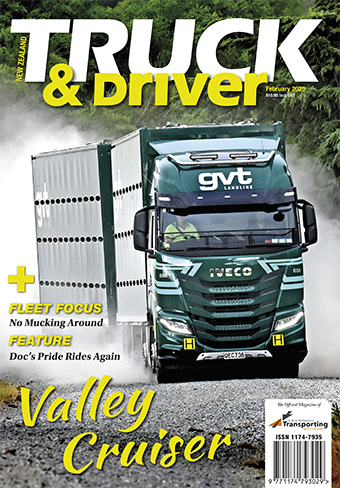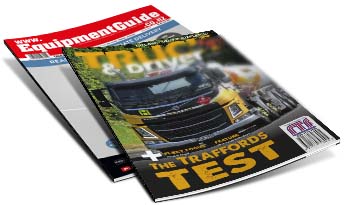Double Coin Imaging Awards


Super-low...super yellow
Double Coin Imaging Awards
A change of colour scheme based on "gut feeling" has stood the test of time for Auckland company Carr & Haslam – this month's finalist in the PPG Transport Imaging Awards.
The striking yellow paint, broken by a brown stripe with an orange highlight, is shown off to good effect on the newest addition to the fleet – a low-riding Mercedes-Benz Arocs 3246 vehicle transporter.
"It's a really smart-looking truck," says Chris Carr, a director of the historic family business, which now specialises in transporting light vehicles, carting LPG and general freight.
One of the oldest road transport operators in the country, Carr & Haslam was established in 1862 – operating as a horse and cart carrier until adding its first truck over 60 years later.
A change of colour scheme based on "gut feeling" has stood the test of time for Auckland company Carr & Haslam – this month's finalist in the PPG Transport Imaging Awards.
The striking yellow paint, broken by a brown stripe with an orange highlight, is shown off to good effect on the newest addition to the fleet – a low-riding Mercedes-Benz Arocs 3246 vehicle transporter.
"It's a really smart-looking truck," says Chris Carr, a director of the historic family business, which now specialises in transporting light vehicles, carting LPG and general freight.
One of the oldest road transport operators in the country, Carr & Haslam was established in 1862 – operating as a horse and cart carrier until adding its first truck over 60 years later.
The company trucks were blue for around 50 years after that – until the 1970s, when then general manager Frank Redfern "decided we needed a change, as there were too many other blue trucks on the road," says Carr.
"He decided we needed to stand out and chose yellow. No research went into it, but it's proved to be the right call: It's a safe colour and people recognise us."
The first truck to get the distinctive new livery was a secondhand Leyland eight-wheeler. Now virtually all of the 70-truck fleet are Mercedes-Benz or FUSOs….and all are painted in the distinctive yellow.
The decision to stay with the colour scheme hasn't been without its problems: There was no standard yellow available in the 1970s and '80s, which meant that whenever Auckland Truck Spray was painting company trucks, a fresh batch of paint had to be mixed.
Says Carr: "Whether it was done in cans or 44-gallon drums, there was always a subtle difference.
"We thought the colours were the same, but when we put trucks side by side they always varied."
But the company persevered and, eventually, there was a solution – when Mercedes-Benz came out with a Sulphur Yellow as part of its factory paint options.
"All our Mercedes have come from the factory for over a decade now already painted in Sulphur Yellow," says Carr, adding that these days the "paint-matching technology is much more sophisticated – and we can get exactly the same Sulphur Yellow to paint the FUSOs."
The brown stripe and the boxed C&H logo (which was also Frank Redfern's idea) were introduced with the colour change to yellow in 1974.
The orange highlight came in the mid-'80s – "purely by chance," says Carr: "We were discussing the need to lift the look of the brown stripe. Somebody happened to be drinking a can of Fanta at the time. Tony Jones from West Auckland Signs suggested the Fanta orange and we've stuck with it ever since."
The C&H logo was initially brown, then was changed to a reflective gold vinyl in the 1980s...and then, three or four years ago, to its current yellow (a darker shade than the Sulphur Yellow).
Carr is proud of the look of his fleet and endeavours to keep it looking as good as possible….for as long as possible, by getting a protective clear film applied to all the working areas on the front and sides of the truck and trailer units to protect them from stone chips.
"We have to get repainting done – particularly underneath, where everything gets stone-blasted down to the bare metal." Unsurprisingly, he's not a fan of the large amount of chip-sealing used on New Zealand roads: "We've got some of the roughest road surfaces in the world."
The new 460-horsepower (343 kW) Arocs 8x4 (the first of two new identical 10-car truck and trailer transporter units) is the end-product of about three years of discussion between Mercedes-Benz in Germany, North Island dealer Trucks & Trailers, trailer and body builder Jackson Enterprises and Carr – about arriving at a super-low cab and super-low chassis to best suit current car transporter needs.
Together they achieved a chassis height of 935mm, rather than the Arocs' standard 1050mm height. The 8x4 and its two-axle trailer stretch out to 23 metres long.
The car transporter trailers and bodies are typically replaced more often than the trucks, says Carr: "Cars are getting lower and closer to the ground because of the aerodynamic benefits. So the arrival and departure angles of the ramps have to be adjusted." Otherwise, he explains, it would be all too easy to rip the whole front skirt off a vehicle when it's being loaded or unloaded.
Transported vehicles are also getting longer and wider. And, just to further complicate things, more SUVs and utes are now being carried – and they need extra height clearance.
Says Carr: "If we can juggle the loads we can get four vehicles on the truck and six on a trailer unit. But sometimes that's not possible and we have to compromise. The greater mix of vehicles is getting harder to deal with."
And all the time, of course, there's the limitation of the 4.3 metre maximum height restriction to pass under most bridges.
The two-axle Jackson trailer is known as a stinger-steer trailer, which hooks up to a turntable mounted low, behind the Arocs' rear drive axle.
Like the unintentional evolution of the yellow paint work, Carr & Haslam has also evolved: "We've always been a port carrier – but now it's vehicles rather than containers," says Carr. In fact, the company exited container transport about two years ago.
So, whereas 20 years ago the company fleet (then only half its current size) was split evenly between container and vehicle transport, the latter now comprises close to 80% of its work and LPG transport accounts for most of the rest….with just a few curtainsider freight units.




 + EQUIPMENT GUIDE - FREE
+ EQUIPMENT GUIDE - FREE
